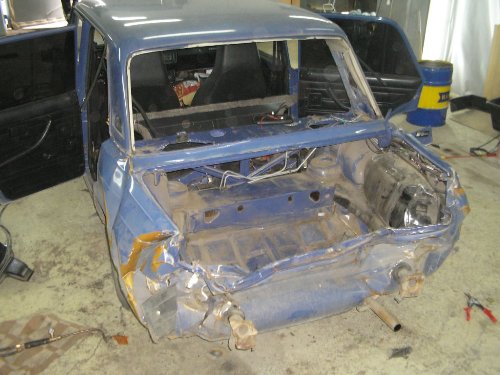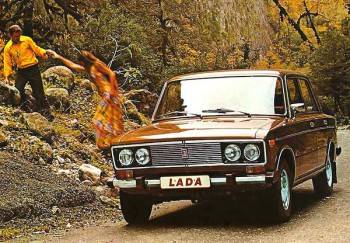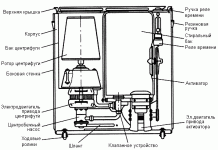The most often changed due to wear are the rubber bushings of the anti-roll bar and rear rods, the anthers of the ball joints and the steering pins. This is followed by the replacement of the ball joints themselves, the steering linkage and the silent blocks. The bearings of the front hubs and rear axle shafts need to be changed as they wear out, a faulty part makes itself felt with a characteristic hum.
Brake pads are a consumable, but the front discs serve for a long time and change when they find workings and furrows on the working surface. Cracks in the front beam are not so uncommon. Small defects can be eliminated by welding, but it must be borne in mind that such auto repair is temporary, the cracked beam will collapse further.
In the brake system, the working cylinders on the wheels often fail. This is due to the fact that the rubber sealing rings become unusable. Motorists know the rule well: it is easier to replace the working brake cylinder once than rubber seals many times. Not so often, but still there are problems with the brake master distributor and the clutch slave cylinder for the same reason.
Transmission parts, well known to the owners of the "classics", are clutch parts that are quite difficult to change on a VAZ 2106 car with your own hands. This is a clutch disc and a release bearing, the "life" of which ranges from 20 to 50 thousand km, depending on the quality of the product.
In order to save money, a car enthusiast can only remove the gearbox from the car in order to take it to the master for repair and subsequent adjustment, and then put it back. The VAZ 2106 gearbox is quite reliable, only in the latest 5-speed models there were sometimes some problems with the 5th gear. The result is the same as with a gearbox - a trip to a specialist.
Most of the above work can be done independently, thereby saving money. The work on the repair of the body of the VAZ of the sixth model was not mentioned, since they need to be performed quite rarely, and this requires the qualifications of an automobile master.
The year of birth of the VAZ-2106 is considered to be 1976. Initially, in the plans, 2106 was produced as a modification of the VAZ-2103, which was called "Car No. 2" before being tested in production. But in connection with the celebration of the 25th anniversary of the Communist Party, it took a completely new model to be presented.Here I had to release the VAZ-2106, as an independent, new model of the domestic auto industry.
VAZ-2106 lasted a record long time on the conveyor - 30 years. To be proud of this, however, did not work out especially, since many considered this model not entirely successful. The design of the "six" was similar to the FIAT 124. It had one engine, which passed to it from the VAZ-2101. But later, domestic developers managed to get documents from foreign colleagues for a 1.5-liter internal combustion engine, similar in components, but adapted for the greatest amount of work.
The Russian engineers did not have time to invent a new, unique engine, so they decided to do something more practical. They took as a basis the engine from FIAT 124 with a volume of 1197 cm³ and bored it under 1293 cm³. As a result, this work bore fruit in the form of a spare engine for the VAZ-21011. The same technology was used for the "six" and the engine was bored from the three from 76 to 79 mm and the volume of 1568 cm³.
It took much longer to develop the design. There are new decorative elements: a steering wheel with monograms, new taillights and plastic glasses for the front optics. The interior of the car also underwent changes, they added a console in the center, installed a dashboard brightness control and head restraints on the seats. By the way, the troika was deprived of them. The seats and the stove were also improved. The panels on the doors were decorated with an ornate oriental design. All changes and improvements to the model were recorded in the report, which was presented by the engineers at the party congress. In this form, the car left the assembly line until 2006.
For 30 years, the "six" was produced by the plant in this modification, adapted for the Russian car enthusiast. The car is reliable, quite economical in terms of gas mileage, outwardly nice and practical. The most important thing in the VAZ-2106 was the cheapness of its spare parts; repairs were available for almost every driver. Going for a long distance, the car owner only had to carry a standard set of keys and several pullers, as well as a valve dipstick. But the developers recommended hiding spare clutch discs, generator brushes and a distributor cover in the trunk.
"Six" could be called a good start for a novice driver. After all, she was like a designer, disassembling and assembling which one could get enough experience in the field of auto repair work. Using the VAZ-2106 as an example, one could learn to understand auto-electrics, ignition, and the structure of the starter. Even to check the readings of the tachometer with the engine speed, only by ear, a simple "six" could teach.
A significant plus is that after many years the body of the "six" has not undergone significant changes. That is why even now the repair of this car costs a penny. Any part can be purchased in a store for a reasonable price, in addition to stores, all consumable parts are sold hand-held at any auto-analysis. The most vulnerable points of the car are the sills, underbody, side members and wheel arches. Under a major overhaul, it was assumed that the wings and sills would undergo replacement. Each VAZ owner knew that they needed to be treated with anti-corrosion mastic, for example, Movil for a car. Today the assortment of Moviles is great, but the "six" is unpretentious, even bitumen mastic is suitable for it. Also, such a mastic had a soundproofing effect, which was necessary for the body of the VAZ.
The price when choosing an anti-corrosion lubricant is not a determining factor, since the result from both expensive and cheap mastics will be the same. The main thing in this work is not how to lubricate the car body, but how to do it. If the threshold is in good condition, then you can do only by pumping the mastic in those places where it is necessary, and the same should be done with the bottom. The front apron also needs to be processed, as its service life varies from 8 to 9 years.If the apron is in good aesthetic condition, then it favorably emphasizes all the external advantages of this model.
When repairing the body, pay special attention to the shock absorber thrust cups, front and rear. There are two problems here: the cup itself breaks out completely and the inlet under the stem breaks. But the plus in all this is that these parts are in accessible places. The reason for this may be the driver's inattentive attitude to his transport, because such a car must be carefully listened to and, at the slightest extraneous sound, drive it to the overpass. In the case when a thud is heard near the upper mount of the shock absorber loud enough, then most likely the problem is in the wear of the bushing. It is necessary to replace this part in time, otherwise the hole for the stem will break and it will be necessary to weld on the washer.
If the ball joints are not original, they need careful control, otherwise the wheel may come off at high speed. In order to check its condition, you need to swing the front wheel in the loaded position, and the knock of the support from below will be heard well, and the backlash will tell you about problems with the stepped bearing. The lower arms do not stand out for their strength and endurance either.
Even at the time of the FIAT124 tests, which took place at the Dmitrovsky proving ground, in some cars the lower arm crumbled at the tenth thousand kilometers. The Italians took this problem into work, tried to fix it, but did not succeed in doing it completely. All these flaws with the suspension could be bypassed, but all further tests of both the "troika" and the "penny" Lada were carried out already during their conveyor production, and, accordingly, there was no time for revision. Therefore, each VAZ owner should carefully monitor the fastening of the shock absorber and the silent block.
The VAZ-2106 engine can rightfully be considered the most successful invention of the plant, because almost all minor defects in its design are easily removable. Naturally, the 1.6-liter engine was not a rival to its foreign peers, but it was the best among the domestic auto industry of those years. The only difference between the six engine and the three engine was the cylinder diameter of 79 mm and the cylinder head, but the reliability properties remained the same. As an experiment, cars of the sixth model and with an engine of 1300 cubic meters were produced, but this was not crowned with success, since such an engine was too weak for this body.
The combination of the processes of replacing consumable parts and their adjustment, in fact, is the repair of the VAZ engine. Blue smoke will tell you about the failure of the oil seals and valves. At the time of their replacement, you can check the condition of the camshaft and drive chain. If the camshaft housing is in good condition, then you can safely assemble the head.
It is not worth saving on the replacement of gaskets, since the sealants will not be able to reanimate them, this unnecessary work will take a lot of time and effort, and this is all in vain, since the cost of the gasket is low. Due to the fact that Italian-made oil seals are more elastic, unlike domestic ones, when replacing them, you need to choose them or factory ones. Foreign oil seals are much more expensive, but their wear resistance and service life are higher. Nearly all six-wheel carburetors are reliable and easy to adjust. One of the first carburetors, when properly tuned, consumed fuel from 8 to 9 liters per 100 kilometers, although in design it was much simpler than Ozone or Solex.
For a non-new car, this is a positive aspect. At the time of setting up a standard carburetor, it is enough to flush it only occasionally, and then it will not require serious investments. High-speed thrust can be caused by replacing the nozzles. For this reason, fuel consumption will increase. All the shortcomings of the factory assembly are easily fixable and do not require large expenditures.
When troubleshooting production problems, you only need to plan the correct placement of the carburetor plane: the lower part to the manifold. If you have the right tools, you can get rid of the casting defect in the carburetor diffusers. And you can also choose the mating of the holes of the cylinder head and the intake manifold. After these manipulations, the fuel mixture will be normal, and problems with filling the cylinder and the speed of the working mixture will not be relevant. The result of the work will be a revived and more powerful Lada motor.
Almost fifty years later, the VAZ chassis remains in good working order, and even drum brakes will not require replacement with modern disc brakes. For the speed at which the car works, such brakes perform all their functions perfectly, and if you carry out timely replacement of the pads, then there will be no problems at all. Maintenance of the steering gear does not require any special manipulations, but only an oil change. Its condition can be assessed both on the go and during parsing. A problem with this mechanism can arise only if the owner did not notice and missed the moment of lubricant leakage at the place where the steering column is attached to the shaft of the entire mechanism.
It is striking that even after a major overhaul, the Zhiguli perfectly serve their owner. And those cars into which the TAD 17 transmission oil was poured according to the regulations do not know any problems with the gearbox at all during the entire operation of the car. If you carefully and attentively treat the VAZ-2106, eliminate all the defects that have arisen on time, listen to the engine's operation, then the machine will respond with reliability and will never fail in difficult times.
Summing up, we can say that the domestic car VAZ-2106 was produced for an ordinary person with an average income. Its service will not hit your pocket and will not take much time. All spare parts are always available in stores or at auto-analysis. Any Zhiguli owner, without the education of an auto mechanic, can easily replace consumables, thereby gaining tremendous experience in car repair.
VIDEO
Contents: We insulate a car Body treatment Insulation of doors Insulation of the engine compartment.
Contents: Prestarting heater Types, features of work Installation of equipment on a car.
Contents: Some nuances Antifreeze heater 220 V Heating device.
Contents: Longfei heaters. Design features Models and their characteristics “Little.
Contents: Types of heaters, features of "Alliance-2-PC" "Alliance" "Alliance -07" "Alliance-08" etc.
Contents: Viscosity Oil type Gear oil Video - What kind of oil is in a car.
Content: VAZ-2106 engines and their consumption What affects consumption.
Contents: Timing features Stages of work, tools Preparatory work Sequence of adjustment.
One of the design features of the gas distribution mechanisms of VAZ engines of classic models.
Contents: A little theory When you need to bleed the brakes Tools Work.
Contents: Detonation - what is it Detonation and glow ignition.
Contents: Preparing a car for the winter period Starting the engine with a carburetor.
Contents: What you need to have in a car in winter Preparing the cooling system.
In 1974, at the Volga Automobile Plant, it was decided to update the VAZ-2103 model. Initially, all renovation work boiled down to reducing the cost of a car for reducing the use of chrome decorative elements and processing lighting equipment under the then European standards.
Such seemingly minor modifications, at first related only to the body, but later affecting the interior of the car, led to the appearance of one of the most popular VAZ cars. At first, they wanted to assign the index 21031 to this car, but in the end the model was designated as VAZ-2106.
The popularity of the model can be estimated by the period of its release - the first "six" rolled off the assembly line in 1975, and the last - in 2005.At first, the VAZ-2106 was considered one of the most comfortable mass-consumption cars, and at the end of its production it was an inexpensive workhorse with a minimum of necessary amenities.
Engines used 30 years of existence did not pass without changes in the design, this sedan almost constantly changed, although these changes were not particularly significant.
For the new modification, the engine was upgraded from the VAZ-2103, increasing its total cylinder volume to 1.6 liters, which provided 75 liters at the output. With.
As in previous models, for the "Six" it was possible to install other power units. Subsequently, a version of the VAZ-21061 appeared with a power plant from 2103, and a little later, a version 21063 with an engine from 2101.
All engines installed on the VAZ-2106 were 4-cylinder, with a liquid cooling system. In the base model, the power plant developed 75 hp. with., the VAZ-21061 engine developed 71 liters. with., and 21063 - 64 "horses".
Initially, all models were equipped with a carburetor power system with a Weber carburetor. Since 1980 it was replaced by Ozone.
In 1990, another version appeared - 21065. A base 75-horsepower unit was installed on this version, and the Ozone was replaced with a Solex carburetor borrowed from the VAZ-2105.
The culmination of the modernization of this car was the release of modification 21067, which appeared in 2002. This version had a fuel injection system with a catalytic converter.
But in general, the VAZ-2106 engines and modifications, in addition to modernizing the power supply system, did not change much.
VAZ-2106 and its modifications were exclusively rear-wheel drive vehicles. Again, at first, the transmission was completely borrowed from the VAZ-2103. The gearbox was mechanical, 4-speed. All models were equipped with such a box until the appearance of modification 21065, which had a 5-speed gearbox.
The torque to the rear axle was transmitted by a cardan shaft passing under the bottom of the car.
The rear axle of the VAZ-2106 had a bevel main gear and a differential. Rotation to the wheels was transmitted using semi-axles.
To damp vibrations that the wheels of a car perceive from the road surface, the VAZ-2106 design included a front independent suspension, a dependent suspension was used on the rear axle.
The front suspension consisted of two wishbones - upper and lower, a shock absorber strut with a coil coil spring, a suspension cross member, to which it is attached, and an anti-roll bar.
The wheel hub was attached to the levers using two ball bearings.
The rear suspension, as already indicated, was dependent. The rear axle was hinged to the car body. This connection was provided by two lower and two upper rocket rods installed longitudinally, as well as one transverse rod. Not without the use of shock absorbers and coil springs in this suspension.
The steering gear of the VAZ-2106 consisted of a steering gear and a drive. The steering gear installed on this car was of a worm type, the gearbox of which was located in the crankcase. This mechanism was attached to the left side member of the body.
The force from the gearbox was transmitted by means of a bipod to a system of levers, including side and middle links and a pendulum arm. The pendulum arm was additionally attached to the right side member with a bracket.
The lever system was connected to the steering knuckles of the front hubs.
The braking system is double, including service and parking brakes.
The working system included a hydraulic drive and working mechanisms. The drive was double-circuit, providing the division of the drive into two independent parts - one circuit actuated the front mechanisms, and the second circuit - the rear ones. This ensured the operability of the system during the breakdown of one of the circuits.
The front brakes were disc brakes, and the rear ones were drum brakes. The presence of a drum mechanism made it possible to use the mechanism as a parking brake.
The parking brake was mechanical; by means of a cable, the driver acted on the mechanism that ensures the release of the pads and the rear wheels were locked.
The electrical circuit used on the VAZ-2106 was single-wire. The car body itself acted as a negative wire. The electrical equipment was classic - the battery and the generator were the energy sources, and the starter, the ignition system, the light and sound signaling system, the heating and ventilation of the passenger compartment were the consumers.
At different times, adjustments were made to the electrical equipment: the signal lights on the doors were replaced with reflectors, some models were equipped with a heated rear window, over time, the light equipment began to include a rear fog lamp.
Most of the electrical equipment was powered by electricity only after turning the ignition key. But there were also elements that were constantly powered - a sound signal, an alarm, a cigarette lighter, a courtesy lamp, and signal lights for open doors.
All VAZ-2106 cars received passport data, which were applied to the car in certain places in the form of plates and markings.
So, the main plate with data on the car was located in the engine compartment on the right side of the air intake box. This table was attached to the body with rivets.
The designation of the car model, engine model, mass characteristics of the car, identification number and number for spare parts, data on the manufacturer were applied to this table.
At the same time, some of the data was still encrypted in an identification number, which included:
International code of the car manufacturer;
Car model;
Year of issue code;
Car body number;
Next to the main plate, the identification number was stamped on the box again. Some factories that let in the VAZ-2106, in addition, next to the plate, glued a sticker with the same number.
Also, the identification number was applied at the top on the front wall of the trunk. It, too, was stamped.
The power plant had its own number, which was stamped along with the engine model on the tide of the block, next to the gas pump.
The dashboard of the VAZ-2106 was borrowed from the VAZ-2103 model. All devices were separated, each sensor was separate. Above the steering column were two large round gauges - a speedometer and a tachometer, below which a reset knob was installed from the daily mileage indicators.
To the left of these sensors, three small auxiliary sensors were placed in a row - Oil pressure, temperature and fuel tank. Three function keys were placed under these sensors - turning on the wipers, head light and heated rear window.
The ignition switch was located below the dashboard, to the left of the steering column.
These are the main characteristics and design features of the VAZ-2106 car. And although now it is no longer produced, there are still a lot of fans of this car, which means that this model will “travel” on the roads for a long time.
Car number 2. This was the name of the VAZ 2103 before the factory tests, and the six was supposed to be just a modification of it, VAZ 21031. But the deputy general director of VAZ vowed to release a new model for the next XXV sabbath of the Communist Party, so the documentation had to be urgently changed. So in 1976, a new model appeared in Togliatti, and in fact, a modernized FIAT 124, VAZ 2106.
In the photo VAZ 2106, in fact, is a modernized FIAT 124
30 years on the assembly line is no joke to you. True, the merits of VAZ in this are few. For many, this is a sore subject, so we will not touch it, but let's see what the new model went to the people with in 1976. In the 70s, the VAZ had only one engine, which he inherited with the VAZ 2101, but the engineers managed to obtain documentation from the Italians for the second, one and a half liter internal combustion engine, identical in design, but adapted for a larger working volume.
Since there was no time to develop new engines for new modifications, they acted straightforwardly and in our own way. The engine from Fiat 124 with a volume of 1197 cm³ was bored under 1293 cubic meters, as a result we stocked up with an additional motor for 21011. The same was done with the six. The engine of 1451 cm³ from the three was bored from 76 to 79 mm to a volume of 1568 cubic meters. Here is the six for you.
With the design, they acted more carefully. It took three years to develop. As a result, they developed a steering wheel with monograms, plastic glasses for the front optics and new taillights.
Video review of the six VAZ 2106
VIDEO In the cabin, they added a center console, a dashboard, cut in a twist to change the brightness of the tidy and installed head restraints in the basic (although there were no others) configuration, which the three did not get. The stove was improved, the seats were modernized. The door panels were decorated with a basurman pattern, and the preparation of the new model was completed, which was successfully reported at the party congress. The car was on the conveyor belt at different factories until 2006.
This is how we got the six, and this is how it remained for all 30 years on the assembly line, and it is so now - reliable, moderately gluttonous, cute in Italian and maintainable in Russian. Indeed, to repair the six, it is enough to have several standard sets of keys, a couple of pullers (for ball joints and steering rod ends), a semi-automatic welding and a probe for adjusting the valves of the block head. Already only with this set on it you can go even on a round-the-world trip, even to a desert island, hiding in the trunk a spare clutch disc, distributor cover and generator brushes.
VAZ 2106 has Italian appeal and Russian maintainability
Absolutely everything can be done with your own hands, and with benefit. For young men who are pale, with an eye not indifferent to technology, this car will be the best school for a novice car mechanic. If you have ever disassembled and assembled the DAAZ 2106 carburetor, you are not afraid of any injectors anymore. The six will teach you to understand automotive electrics, explain empirically what early ignition is, a closed starter, will make you compare the speed shown by the tachometer with the engine speed by ear - believe me, this is an invaluable experience. If you make friends with this old woman, she will reciprocate, because this is one of the last domestic cars that has a soul, and it is not hidden in an electronic control unit.
The body of the six is simple, reliable, any piece of iron can be bought for a penny. If not in the store, then with hands. On the one hand, it is good that neither the plumage nor the other bodywork has undergone any changes over so much time. Therefore, the body repair of 2106 20 years ago is no different from the car produced a couple of years ago at the Izhevsk plant. Metal is only worse.
VIDEO Sore spots of the body - wheel arches, sills and underbody cavities, spars and engine compartment drains. If a major overhaul was carried out, then it was supposed to replace the wings and thresholds, which, without fail, the handy owners poured with anti-corrosion mastic. Then Movil Auto was considered number one, today there are a dime a dozen of such Moviles. But the six will not be offended by the bituminous mastic, which, by the way, also has soundproofing properties. Muting the body of old Zhiguli will definitely not hurt.
Only here you need to clearly define the price segment, and not rush to expensive mastics and anticorrosives. There is little more sense from them than from simple and cheap ones, but the price is still twice as high. The main thing is not how to handle the body, but how. If the thresholds are in a normal state, then in the cavity you can simply pump the mastic with a syringe, after which plugging the plugs. The same should be done with the bottom boxes. The front headlight lasts 8-9 years, but it is better to play it safe and process it. A neat, not wrinkled apron emphasizes the virgin simplicity of the six, especially when paired with a native shiny bumper, square fangs and plastic sidewalls.
When repairing the body of a VAZ 2106, always check the condition of the car's suspension
Even when repairing the body, be sure to pay attention to the thrust cups of the shock absorbers. Both front and rear. Fortunately, they are in prominent places and they have two problems - the hole for the shock absorber rod breaks and sometimes pulls out the cup itself. And all this happens suddenly, through an oversight of the driver. The six must be listened to, and if the thud in the area of the upper shock absorber mount is too pronounced, it is possible that the bushing is simply worn out. If it is not replaced in time, the rod will break the hole and then you will have to weld on the washer.
Ball joints are another, more precisely, two, unpleasant moments. If the ball is not original, it needs an eye and an eye. Otherwise, you can lose a wheel at speed, and this does not shine with anything good. It is easy to check the condition of the supports. It is enough to swing the front wheel in the transverse plane in a loaded state, and the knock of the lower support will be heard immediately, and the backlash can speak either of a dying support or of troubles with a wheel bearing. The lower arms are also not particularly durable.
VIDEO Even when the Fiat 124 was tested at the Dmitrov training ground, at the tenth thousand, the lower arm of some experimental cars simply crumbled. The Italians took into account, modified and corrected, but not completely. Perhaps problems with the suspension, especially with the front, could have been avoided, but it so happened that the interdepartmental trials of both Kopeyka and Troika were already taking place against the background of a mass conveyor production, there could be no question of modifications. Therefore, attention should be paid to the lower levers in the area where the shock absorber and silent blocks are attached.
The six-wheel drive is the success of the plant. Yes, he had flaws in the constructive part, but they are all fixable if desired. Even if the engine with 1.6 liters of volume could not compete in power with European peers, this is the best that was in that country. Structurally, it differed from the three only with a cylinder diameter of 79 mm and a cylinder head. But he was just as reliable and unpretentious. There was a VAZ 21063 version, on which a 1300 cc engine from the eleventh model was installed, it was frankly weak for this body, which was not much heavier than a penny.
VIDEO The current repair of the 2106 motor consists mainly of adjustments and planned replacements of consumable parts or pump bushings. These processes are easy to combine. Gray smoke went up - in the best case, the valve seals were killed. And when replacing them, it is easy to view the condition of the camshaft, drive chain, gaskets and gears, make sure that the camshaft housing is normal, then you can assemble the head and be sure that it will not fail.
As for rubber-technical consumables and gaskets, there is no need to feel sorry for them. A squeezed gasket will not be saved by any sealant, and they are not so expensive to save on them. It is better to install oil seals for VAZ engines either factory or Italian. The latter are more preferable, since there were cases when, after an overhaul of the engine, Italian oil seals were more elastic than new domestic ones. They are twice as expensive, but their life is guaranteed. All carburetors that were installed on the six are quite reliable and flexible in adjustments. The very first was not as complex in design as Solex or Ozone, but with correct adjustment it kept fuel consumption within 8-9 liters per hundred.
VIDEO For an old car, this isn't too bad. Regulating the standard carburetor is simple, it needs to be flushed periodically, and then there will be no need for tuning. Replacing the jets will not bring adequate changes - thrust may appear at high speeds. But the bottom will disappear, and fuel consumption may not change for the better. This engine has the least complaints about the carburetor. More questions are raised by the quality of the factory assembly, although this is fixable.
To eliminate factory "knots", it is enough to plan the landing planes of the carburetor - the lower part to the manifold.And if there is an opportunity and a set of a young engraver, you can remove casting defects both in the carburetor diffusers and adjust the mating of the cylinder head and intake manifold holes. Then the fuel mixture will not experience parasitic eddies that affect the speed of the working mixture and cylinder filling. Having done these simple operations with the carburetor and intake manifold, the motor of the six will come to life and show what it is capable of.
Old drum brakes VAZ 2106 do not need to be replaced with disc brakes
The chassis, despite the fact that it is constructively more than half a century old, does not irritate with its archaism. If you look at it, even antediluvian drum brakes do not require replacement with disc brakes. They quite cope with the car at the speeds that are available to it, and do not cause any complaints with timely replacement of brake pads. The condition of the steering gear is assessed both on the fly and during repairs, but its maintenance consists only in changing the oil. It is extremely rare that the steering mechanism wedges and this happens when the driver missed the moment of lubricant leakage, and it can leak in the place where the steering column is attached to the mechanism shaft.
VIDEO The checkpoint of old Zhiguli is striking in its reliability and durability. There are copies of sixes, the owners of which do not know what a gearbox repair is. As a rule, these are cars that have never seen Castrol or Shell oils before, and only the transmission TAD 17 was poured into the box, but according to the regulations.
Video (click to play).
VAZ 2106, with a good attitude towards itself, will show what a classic rear-wheel drive layout is capable of, and if you treat the car with soul, then this oak will make noise for more than a dozen years.











